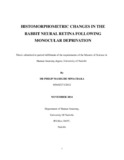| dc.description.abstract | Background: Monocular deprivation in experimental animals results in both anatomical and
electrophysiological changes in the visual cortex in favor of the non-deprived eye, a phenomenon known
as ocular dominance plasticity. Although the retina is considered part of the nervous system based on its
embryonic development and its cellular content, there is scarcity of information on the anatomical
changes occurring in the retina as a result of monocular deprivation.
Objective: To describe the histomorphometric changes in the neural retina following monocular
deprivation.
Study design: Randomized-experimental study using a rabbit model.
Material and methods: 30 rabbits (18 experimental, 12 controls) were studied. Experimental animals
were monocularly deprived of light by suturing the lids of one eye at postnatal day 14. At baseline
(postnatal day 14), three control rabbits were euthanized, their retina harvested and processed for light
microscopy. Thereafter at postnatal days 21, 28, and 35, three control and six experimental animals were
euthanized, their retina harvested and processed for light microscopy by paraffin embedding. Retina of
both deprived (closed) and non-deprived (open) eyes in experimental animals were studied.
Haematoxylin & Eosin stain was used to demonstrate the layers and cellular detail of the retina, while
Golgi stain was used to elucidate the processes of ganglion neurons. Photomicrographs of the retina
were taken using a Canon® digital camera that was mounted on a Leica® photomicroscope.
Data analysis: The photomicrographs were entered into Fiji-ImageJ® processing and analysis software.
The variables measured included: thickness of each layer of the neural retina, cell densities in the nuclear
layers, and dendritic features of the ganglion neurons. Data gathered were entered into Statistical
Package for Social Sciences software (version 17.0 Chicago, Illinois) for analysis. Analysis of Variance
was used to compare the differences in means of each variable with increasing duration of monocular
deprivation. The Student’s t-test was used to compare the differences in means between the experimental
and control animals. A p value <0.05 was considered significant at 95% confidence interval.
Results: From the P14 to P35, the neural retina thickness in the deprived eyes, reduced by 40.5%
(p=0.001). Compared to controls, statistically significant differences were noted in the ganglion cell
layer (p<0.001), inner nuclear layer (p<0.001), rod and cones layer (p=0.001), outer plexiform layer
(p=0.008), nerve fiber layer (p=0.010), and inner plexiform layer (p=0.024). There was generalized
reduction in the cell densities of the deprived eyes with increasing period of deprivation, with the percent
reductions being ganglion cell 60.9% (p<0.001), inner nuclear layer 41.6% (p=0.003), and outer nuclear
layer 18.9% (p=0.326). The number of primary and terminal dendrites as well as the dendritic field area
reduced with increasing period of deprivation, but the differences were not statistically significant
compared to the controls.
Among the non-deprived eyes, the neural retina thickness increased by 9.8% from P14 to P35 (p=0.075).
Compared to controls, statistically significant differences were noted in the inner plexiform (p<0.001),
inner nuclear (p=0.002), and rods and cones (p=0.007) layers. The cell densities increased with
increasing period of deprivation, with the percent increments being ganglion cell 116% (p<0.001), inner
nuclear layer 52% (p<0.001), and outer nuclear layer 59.6% (p<0.001). The number of primary and
terminal dendrites, and dendritic field area increased with prolonged period of deprivation. Compared
to controls, non-deprived eyes had 114.3% more terminal dendrites (p=0.002), while the number of
primary dendrites and dendritic field area did not display statistically significant differences.
Conclusion: Monocular deprivation results in retinal thinning, reduction in cell densities and synaptic
contacts in the deprived eye, with compensatory changes occurring in the non-deprived eye. These
changes in the retina may contribute to the changes seen in the visual cortex in monocularly deprived
animals. | en_US |

